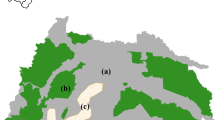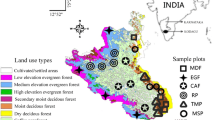Abstract
Agroforestry systems are the most promising land use practice for achieving both conservation goals and supporting rural livelihoods at landscape level. Coffee agroforests in Western Ghats region of India are sustainably managed under the shade of native trees. Kodagu district located in the Central Western Ghats is the largest shade coffee-growing regions in the country hosting rich biodiversity. In the recent years, the landscape is undergoing transformation in terms density and diversity of shade trees to increase coffee production. With the base line data from Coffee Agro-Forestry Network project during 2008, the present study was carried out during 2017 in four villages under Cauvery watershed, namely Arekad, Hachinad, Yeduru and Byrambada. The important objective of this study was to analyze the changes in tree diversity and structure and the effect of land tenure systems on tree density. We adopted similar sampling procedures for tree enumeration as that of first census conducted during 2008. Results revealed that the Grevillea robusta remained as the dominant tree species with an increased importance value index from 36.05 to 2008 to 53.29 in 2017. Tree density decreased significantly from 2008 (420 ± 349 number of stems ha−l) to 2017 (274 ± 82 number of stems ha−l). Basal area has increased from 2008 (27.62 ± 11.27 m2ha−l) to 2017 (30.31 ± 11.03 m2ha−l). Among the tenure systems, tree density was higher in unredeemed coffee farms compared to redeemed coffee farms. In this study, the sampling was limited to the Cauvery watershed. Therefore, we recommend further studies to address the dynamics of tree diversity and structure covering larger part of the coffee-growing region.




Similar content being viewed by others

References
Amanda S, Caudill P, Vaast TP (2014) Husband (2014) Assessment of small mammal diversity in coffee agroforestry in the Western Ghats, India. Agrofor Syst 88:173–186. https://doi.org/10.1007/s10457-013-9664-3
Anonymous (2014) National Agroforestry Policy 2014, Department of Agricultural and Cooperation, Ministry of Agricultural, New Delhi.http://www.agricoop.nic.in/imagedefault/whatsnew/Agroforestry.pdf
Basavarajappa S (2017) Studies on population status and propagation of bee forage trees of coffee based agroforests. M.Sc. thesis, Univ. Agric. Sci., Shivamogga, Karnataka (India), pp 60–72
Bhagwat SA, Katherine J, Willis H, Birks JB, Whittaker RJ (2007) Agroforestry: a refuge for tropical biodiversity. Trends Ecol Evol 23(5):261–267
Bhagwat SA (2002) Biodiversity and conservation of cultural landscapes in the Western Ghats of India. Ph.D. thesis, University of Oxford, United Kingdom, pp 227
CAFNET Project (2011) website for India http://www.ifpindia.org/Coffee-and-Environmental-Services-in-the-Western-Ghats.html
Chazdon RL, Lindenmayer D, Guariguata MR, Crouzeilles R, Benayas JMR, Chavero EL (2020) Fostering natural forest regeneration on former agricultural land through economic and policy interventions. Environ Res Lett 15:043002
Chethana AN, Nagaraj N, Chengappa PG, Gracy CP (2010) Geographical indications for Kodagu coffee-A Socio-economic feasibility analysis. Agric Econ Res Rev 23:97–103
Coffee Board of India (2016) Database on Coffee. Bangalore:Economic and Market Intelligence Unit Coffee Board. http://www.indiacoffee.org/coffeeinindia/default.htm
Condit R, Hubbell SP, Foster RB (1996) Changes in tree species abundance in Neotropical forest: Impact on climate change. J Trop Ecol 12(2):231–256
Dallmeier F, Comiskey JA (1998) Forest biodiversity assessment, monitoring and evaluation for adaptive management. In: In: Dallmeier F, Comiskey JA (eds) Forest biodiversity research, monitoring and modeling: conceptual background and old world case studies. Parthenon Publishing, Paris, pp 183–196
Davari N, Jouri MH, Ariapour A (2011) Comparison of measurement indices of diversity, richness, dominance, and evenness in rangeland ecosystem. Rangeland J 2(1):389–398
Decocq G, Andrieu E, Brunet J et al (2016) Ecosystem services from small forest patches in agricultural landscapes. Verheyen K (ed) Curr For Rep 2:30–44. https://doi.org/10.1007/s40725-016-0028-x
Devagiri GM, Khaple AK, Anithraj HB, Kushalappa CG, Krishnappa AK, Mishra SB (2019) Assessment of tree diversity and above-ground biomass in coffeeagroforest dominated tropical landscape of India’s Central Western Ghats. J For Res. https://doi.org/10.1007/s11676-019-00885-1
Elouard C, Chaumette M, Pommery H (2000) The role of coffee plantations in biodiversity conservation (Coffee and Biodiversity Conservation – Chapter 6). In: Ramakrishnan PS, Chandrashekara UM, Elouard C,Guilmoto CZ, Maikhuri RK, Rao KS, Sankar S, Saxena KG (eds) Mountain biodiversity, land use dynamics, and traditional knowledge (eds) Man and the biosphere Programme, Oxford and IBH publishing Co. Pvt. Ltd., New Delhi. pp. 120–149
Fashing PJ, Forrestel A, Scully C, Cords M (2004) Long-term tree population dynamics and their implications for the conservation of the Kakamega Forest, Kenya. Biodivers Conserv 13:753–771
Garcia CA, Bhagwat SA, Ghazoul J, Nath CD, Nanaya KM, Kushalappa CG, Raghuramulu Y, Nasi R, Vaast P (2009) Biodiversity conservation in agricultural landscapes: challenges and opportunities of coffee agroforests in the Western Ghats. Conserv Biol, India. https://doi.org/10.1111/j.1523-1739.2009.01386.x
Garcia C, Nath C, Nanaya KM, Kushalappa CG (2007) Sampling strategy for tree diversity inventories in coffee agroforestry systems of Kodagu district. French Institute of Pondichery, p 4
Garrett RD, Koh I, Lambin EF, Waroux YP, Kastens JH, Brown JC (2018) Intensification in agriculture-forest frontiers: land use responses to development and conservation policies in Brazil. Glob Environ Change 53:233–243
Gwali S, Agaba H, Balitta P, Hafashimana D, Nkandu J, Kuria A, Pinard F, Sinclair F (2015) Tree species diversity and abundance in coffee farms adjacent to areas of different disturbance histories in Mabira forest system, central Uganda. Int J Biodivers Sci Ecosyst Serv Manag 11(4):309–317
Hubbell SP, Foster RB (1990) Structure, dynamics, and equilibrium status of old-growth forest on Barro Colorado Island. In: In: Genry AH (ed) Four Neotropical Rainforests. Yale University Press, Connecticut, pp 522–541
Huxley P (1999) Tropical agroforestry. Blackwell Science, Oxford
International Coffee Organization (2012) Coffee market report.ICO. LondonIzac AMN
Keshavamurthy KR, Yoganarasimhan SN (1990) Flora of Coorg (Kodagu), Karnataka, India. Vimsat Publishers, Bangalore
Kushalappa CG, Vaast P, Yenagulla R, Garcia C, Sinclair F (2011) Coffee agroforestry in Kodagu, Western Ghats, India- need for conservation to sustain livelihoods. In: Proceedings of the 23rd ASIC Colloquium; Bali; ASIC; Paris, pp 1–4
Leakey RRB (1999) Agroforestry for biodiversity in farming systems. In: In: Collins WW, Qualset CO (eds) Biodiversity in Agro ecosystems. CRC Press, Boca Raton, FL, USA, pp 127–145
Mani S, Parthasarathy N (2009) Tree population and above-ground biomass changes in two disturbed tropical dry evergreen forests of peninsular India. Trop Ecol 50(2):249–258
Marcel TJK, Rob A, Michel B, Marthavan E, Jan J, Maryia M, Tom K, Tanya L, Johan M, Markvan O, Henk W, Anne-Gerdien P, Detlef PV (2018) Pathways for agriculture and forestry to contribute to terrestrial biodiversity conservation: A global scenario-study. Biol. Conserv 221:137-150
Mukul SA, Saha N (2017) Conservation benefits of tropical multifunctional land-uses in and around a forest protected area of Bangladesh. Land 6(1):2 https://doi.org/10.3390/land6010002
Muthappa PP (2000) A Resource economic study on tree diversity in coffee based plantations in the Western Ghats region of Karnataka. M.Sc. Thesis, University of Agricultural Sciences, Bangalore. pp. 38-42
Nath CD, Schrothb G, Burslemc DFRP (2016) Why do farmers plant more exotic than native trees? A case study from the Western Ghats, India. Agric Ecosyst Environ 230:315–328
Perfecto I, Vandermeere J (2002) Quality of agroecological matrix in a tropical montane landscape: ants in coffee plantations in Southern Mexico. Conserv Biol 16:174–182. doi:https://doi.org/10.1046/j.1523-1739.200299536.x
Philpott SM et al (2008) Biodiversity conservation, yield, and alternative products in coffee agroecosystem in Sumatra, Indonesia. Biodivers Conserv 17(8):1805–1820. doi:https://doi.org/10.1007/s10531-007-9267-2
Plieninger T, Rojas J, Buck LE, Scherr SJ (2020) Agroforestry for sustainable landscape management. Sustain Sci 15:1255–1266
Poornika Rani BJ (2009) Floristic diversity studies in coffee based agroforestry system. M.Sc. thesis, Univ. Agric. Sci., Bengaluru, Karnataka (India). pp 33–38
Sathish BN (2005) Studies on tree diversity in different land tenure systems in Kodagu, Central Western Ghats. M.Sc. thesis, Univ. Agric. Sci., Bengaluru, Karnataka (India), pp 30–42
Sheil D, Puri RK, Basuki I, Heist MV, Wan, Liswanti N, Ruhmiyati, Sadjani AM, Samsoedin I, Sidiyasa K, Chrisandini PE, Angi EM, Gatzweier F, Johnson B, Wijaya A (2002) Exploring biological diversity and local people’s perspectives in forest landscapes. Method for multi disciplinary landscape assesment, pp10
Shrinidhi A, Sathish BN (2009) Comparing tree diversity and composition in coffee farms and sacred forests in the Western Ghats of India. Biodivers Conserv (2009) 18:987–1000. https://doi.org/10.1007/s10531-008-9502-5
Taylor DA (2007) Certified coffee: does the premium pay off? Environ Health Perspect 115:A456–A459
Zimmerman JK, Willig MR, Walker LR, Silver W (1996) Introduction: disturbance and Caribbean ecosystems. Biotropica 28:414–423
Author information
Authors and Affiliations
Corresponding author
Additional information
Publisher’s Note
Springer Nature remains neutral with regard to jurisdictional claims in published maps and institutional affiliations.
Electronic supplementary material
Below is the link to the electronic supplementary material.
Rights and permissions
About this article
Cite this article
Sathish, B.N., Bhavya, C.K., Kushalappa, C.G. et al. Dynamics of native tree structure and diversity in coffee agroforest: a case study from Central Western Ghats. Agroforest Syst 96, 161–172 (2022). https://doi.org/10.1007/s10457-021-00713-8
Received:
Accepted:
Published:
Issue Date:
DOI: https://doi.org/10.1007/s10457-021-00713-8



